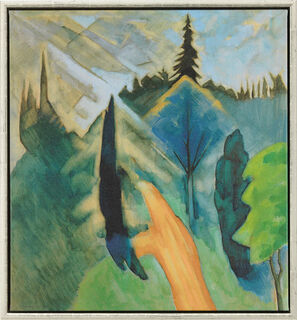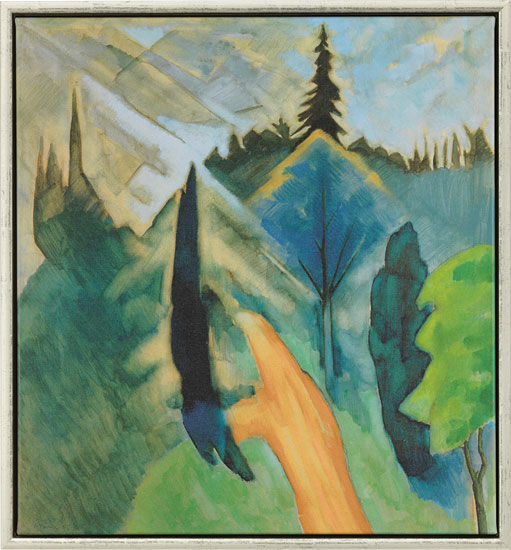Picture "Park in Dilborn with Lime-Green Trees" (1915), framed


Picture "Park in Dilborn with Lime-Green Trees" (1915), framed
Quick info
ars mundi Exclusive Edition | limited, 499 copies | numbered certificate | reproduction, Giclée print on canvas | stretcher frame | shadow gap | size approx. 64 x 69 cm
Detailed description
Picture "Park in Dilborn with Lime-Green Trees" (1915), framed
Heinrich Nauen's watercolours from Dilborn: From 1911 to 1931, Nauen spent his happiest and most artistically productive years together with his wife at Dilborn Castle near Brüggen. The works of this period radiate a profoundly affirmative attitude to life. The castle and its park repeatedly offered him new motifs.
Original: Tempera and chalk. Clemens-Sels Museum, Neuss.
The original artwork was transferred directly onto 100% cotton artist canvas using the Fine Art Giclée process for a brilliant, authentic reproduction and mounted on a stretcher frame. Limited edition of 499 copies with a numbered certificate on the back. Exclusively at ars mundi. Framed in a high-quality silver-coloured shadow gap. Size approx. 64 x 69 cm.
About Heinrich Nauen
1880-1940
Before World War I, Heinrich Nauen belonged to the circle of "Rhenish Expressionism", an artist group that August Macke founded. He named the group after a famous exhibition. The members did not share a common style; their cohesion was determined above all by their affinity to France and their shared interest in the French art movements. The members included illustrious artists such as Franz Marc, Heinrich Campendonk and for a while, even Max Ernst.
In 1921, Nauen became a professor at the Düsseldorf Art Academy and taught alongside Otto Dix and Paul Klee. In 1937, however, his work was denounced as "degenerate" by the Nazis; he died three years later.
Nauen spent his happiest and artistically most productive years with his wife at Dilborn Castle near Brüggen, Germany, between 1911 and 1931. The works of this period convey a profoundly affirmative attitude to life. The castle and its park constantly offered him new motifs.
Graphic or sculpture edition that was initiated by ars mundi and is available only at ars mundi or at distribution partners licensed by ars mundi.
Artistic movement that replaced Impressionism in the early 20th century.
Expressionism is the German form of the art revolution in painting, graphic art and sculpture, which found its precursor in the works of Paul Cézanne, Vincent van Gogh and Paul Gauguin in the late 19th century. The Expressionists attempted to advance to the primal elements of painting. With vibrant, unbroken colours in large areas and with the emphasis on the line and the resulting targeted suggestive expressiveness, they fought against the artistic taste established by the bourgeoisie.
The most important representatives of Expressionism were the founders of "Die Brücke" (The Bridge): Ernst Ludwig Kirchner, Erich Heckel, Karl Schmidt-Rottluff, Max Pechstein, Otto Mueller and Franz Marc, August Macke and others.
Masters of Viennese Expressionism are Egon Schiele and Oskar Kokoschka. Among the sculptors, Ernst Barlach is the most famous.
Fauvism is the French form of Expressionism.
Giclée = derived from the French verb gicler "to squirt, spurt".
The giclée method is a digital printing process. It is a high-resolution, large-format printout on an inkjet printer with special different-coloured dye- or pigment-based inks (usually six to twelve). The colours are fade-proof, i.e. resistant to harmful UV light. They have a high richness of nuance, contrast and saturation.
The giclée process is suitable for art canvases, handmade and watercolour paper as well as for silk.


